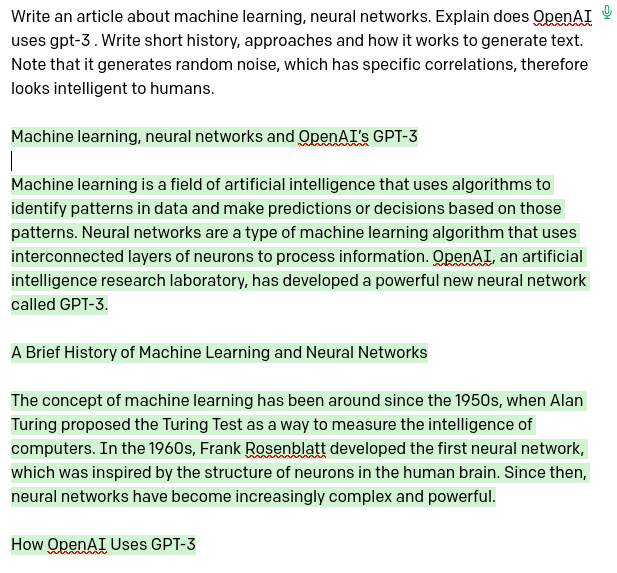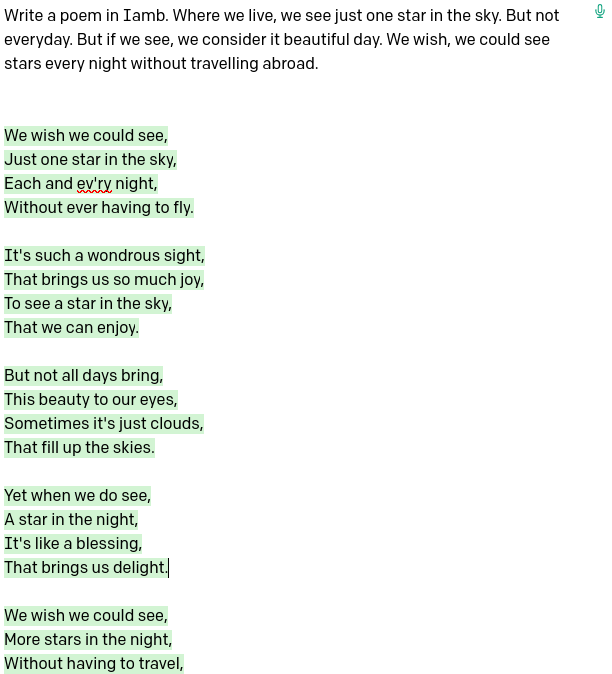
This article is mostly written by https://beta.openai.com/. Note, that OpenAI was also tested for Latvian language, with bit worse results and is described in Latvian version of this entry.
For following following input:
Write an article about machine learning, neural networks. Explain does OpenAI uses gpt-3 . Write short history, approaches and how it works to generate text. Note that it generates random noise, which has specific correlations, therefore looks intelligent to humans.
It produced following output (with some adjustments for logic and consistency):

Machine learning is a field of artificial intelligence that uses algorithms to identify patterns in data and make predictions or decisions based on those patterns. Neural networks are a type of machine learning algorithm that uses interconnected layers of neurons to process information.
The concept of machine learning has been around since the 1950s, when Alan Turing proposed the Turing Test as a way to measure the intelligence of computers. In the 1960s, Frank Rosenblatt developed the first neural network, which was inspired by the structure of neurons in the human brain. Since then, neural networks have become increasingly complex and powerful.
OpenAI artificial intelligence research laboratory has developed a powerful new neural network called GPT-3. It is large-scale deep learning language model, that has been trained on a massive amount of text data from the internet. It is designed to generate text that appears to be written by humans, but is actually generated by the machine. The model is able to generate text that has specific correlations and looks intelligent to humans, even though it is actually just random noise.
GPT-3 is used for a variety of tasks including natural language processing, question answering, and text generation. For example, OpenAI has used GPT-3 to generate news articles and blog posts that appear to be written by humans. Additionally, GPT-3 can be used for more complex tasks such as summarizing long documents or generating dialogue for virtual assistants.
GPT-3 works by taking in input text and predicting what word will come next in the sequence. The model then uses this prediction to generate more text that follows the same pattern as the original input. This process is repeated until the desired amount of text is generated. The model can also be trained on specific tasks such as summarizing or generating dialogue for virtual assistants.
OpenAI's GPT-3 is an impressive deep learning language model that has been trained on massive amounts of data from the internet and can generate text that appears to be written by humans. It can be used for a variety of tasks including natural language processing, question answering and text generation. The model works by predicting what word will come next in a sequence and using this prediction to generate more text that follows the same pattern as the original input.
Below is some other example for generated text:
Write a poem in Iamb. Where we live, we see just one star in the sky. But not everyday. But if we see, we consider it beautiful day. We wish, we could see stars every night without travelling abroad.
And here is output (again, with some adjustments for logic and consistency):
We wish we could see,
If only one star in the sky,
Each and every day,
Without ever having to fly.
It's such a wonderful sight,
That brings us much joy,
To see a Sun in the sky,
That we can enjoy.
But not all days bring,
This beauty to our sights,
Sometimes it's just clouds,
That fill up the skies.
Yet when we do see,
A stars in the night,
It's like a blessing,
That brings us delight.
We wish we could see,
More stars in the nights,
Without having to travel,
Far from our sight.
Getting this text took quite some time, but probably was more fun than writing everything by myself.






